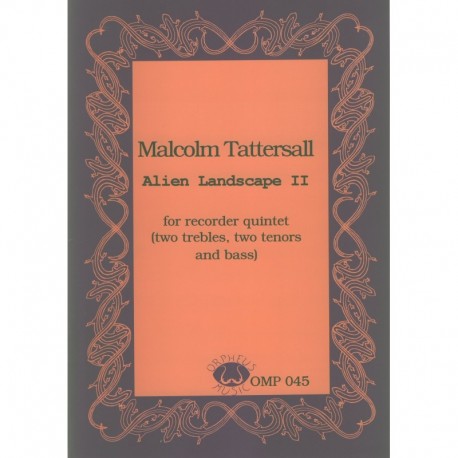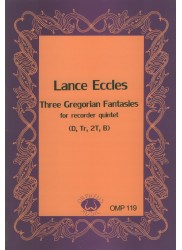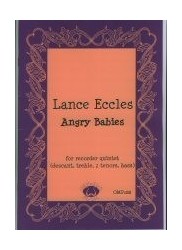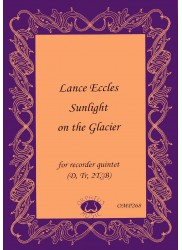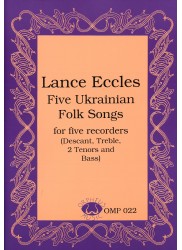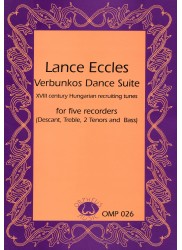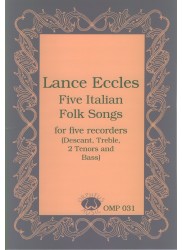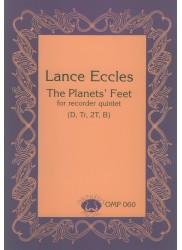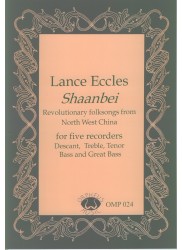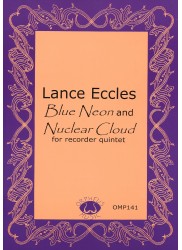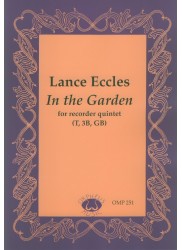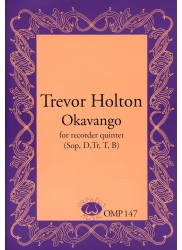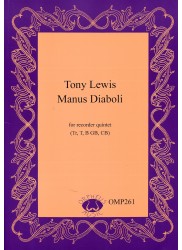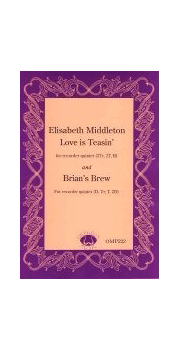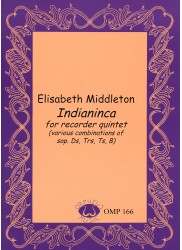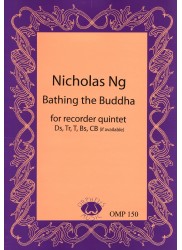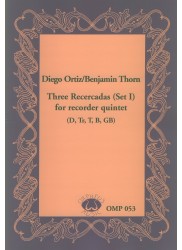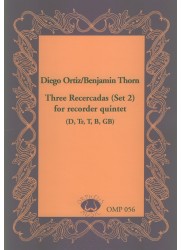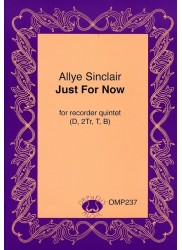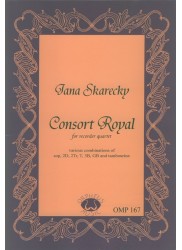No products
Prices are tax included
Alien Landscape II
Composer: Tattersall - Malcolm
Instrumentation: 2 Trebles - 2 Tenors - Bass
Period/genre: Australian Contemporary
Grade: Difficult
More info
*Contemporary Piece.* Atmospheric and evocative with some contemporary techniques.
1. Alien Landscape II
_Score 3 pp. Parts 1 pp._
OMP045 Malcolm Tattersall Alien Landscape II
Written and originally published (by Cootamundra Music) in 1982, Alien Landscape II resembles its counterpart Alien Landscape I (1979, an electronic piece for analogue synthesiser). Using many of the varied and diverse techniques open to the modern recorder player (covering and uncovering the labium, flutter-tonguing, tremolos) as well as effective utilisation of dynamic contrast and staccato notes, the recorder consort is made to sound remarkably akin to an electronic instrument. The Preface explains how the music should evoke the feeling of an unknown countryside at night, where mysterious natural sounds can be heard and the static nature of the piece successfully conjures up this idea.
Alien Landscape II can be divided into several sections each focussing on a different playing technique. All voices begin simultaneously on a dissonant chord (with covering and uncovering of the labium), and one by one the parts shift (mostly stepwise) so that any movement is almost imperceptible. Although the piece is atonal, the dissonances are not unpleasant or jarring, merely expressing an uncertain wandering. Once the muting ceases, grace notes begin to appear before a quasi-melodic movement ending on a gorgeous chord, wholly suited to the timbres used.
There is a section of staccato quavers which appear to have been picked randomly. Here, as throughout the piece, the notes themselves pose no great problems, but the timing when all parts are moving independently is not for the easily dissuaded! There is a brief period of homophonic movement (although getting everyone to play staccato quavers together at the designated crotchet = 48-56 can be "fun"!)
There is a notable section where the timbre of tenor and bass tremolos on their lowest notes is truly haunting, and another where a loose motif is passed briefly around before the last homophonic section. The last five bars use muting and are retrograde of the beginning of the piece in pitch values (although not in time values), perhaps a final message of the uncertainty of this "Alien Landscape".
It is a great relief to see standard notation used for the extended techniques, and also fingering given for tremolos which may be unfamiliar - and the inclusion of five parts and a score is most welcome (if only more publishers would do the same!) However, the timing may be easier to play correctly if all the ensemble can see the score.
Perhaps best suited to more advanced players, not because of the notes, but for the concentration and synchronisation of ensemble required, this piece will be a refreshing new addition to the modern recorder repertoire.
Fiona Devon, The Recorder Magazine, Winter 2000
30 other products in the same category:
Reference: OMP119.pdf
Brand: Orpheus Music
Three Gregorian Fantasies
PLEASE NOTE - DOWNLOADABLE PDF VERSION Composer: Eccles - Lance...
$31.00 -20%In StockReference: OMP188
Brand: Orpheus Music
Angry Babies
Composer: Eccles - Lance Instrumentation: Descant - Treble - 2 Tenors - Bass...
In StockReference: OMP188.pdf
Brand: Orpheus Music
Angry Babies
PLEASE NOTE - DOWNLOADABLE PDF VERSION Composer: Eccles - Lance...
$25.00 -20%In StockReference: OMP268
Brand: Orpheus Music
Sunlight on the Glacier
Composer: Eccles - Lance Instrumentation: Descant - Treble - 2 Tenors - Bass...
In StockReference: OMP268.pdf
Brand: Orpheus Music
Sunlight on the Glacier
PLEASE NOTE - DOWNLOADABLE PDF VERSION Composer: Eccles - Lance...
$22.00 -20%In StockReference: OMP022.pdf
Brand: Orpheus Music
Five Ukranian Folk Songs
PLEASE NOTE - DOWNLOADABLE PDF VERSION Composer: Eccles - Lance...
$23.50 -20%In StockReference: OMP026.pdf
Brand: Orpheus Music
Verbunkos Dance Suite
PLEASE NOTE - DOWNLOADABLE PDF VERSION Composer: Eccles - Lance...
$23.50 -20%In StockReference: OMP031.pdf
Brand: Orpheus Music
Five Italian Folk Songs
*PLEASE NOTE > DOWNLOADABLE-ONLY PDF VERSION Composer: Eccles - Lance...
$23.50 -20%In StockReference: OMP060
Brand: Orpheus Music
The Planet's Feet
Composer: Eccles - Lance Instrumentation: Descant - Treble - 2 Tenors - Bass...
In StockReference: OMP024
Brand: Orpheus Music
Shaanbei Four Folk Songs North-West China
Composer: Eccles - Lance Instrumentation: Descant - Treble - Tenor - Bass -...
In StockReference: OMP024.pdf
Brand: Orpheus Music
Shaanbei Four Folk Songs North-West China
PLEASE NOTE - DOWNLOADABLE PDF VERSION Composer: Eccles - Lance...
$23.50 -20%In StockReference: OMP141.pdf
Brand: Orpheus Music
Blue Neon and Nuclear Cloud
PLEASE NOTE - DOWNLOADABLE PDF VERSION ONLY Composer: Eccles - Lance...
$19.00 -20%In StockReference: OMP141
Brand: Orpheus Music
Blue Neon and Nuclear Cloud
Composer: Eccles - Lance Instrumentation: Descant - 2 Trebles - Tenor - Bass...
In StockReference: OMP251
Brand: Orpheus Music
In the Garden
Composer: Eccles - Lance Instrumentation: Tenor - 3 Basses - Greatbass...
In StockReference: OMP251.pdf
Brand: Orpheus Music
In the Garden
PLEASE NOTE - DOWNLOADABLE PDF VERSION Composer: Eccles - Lance...
$19.00 -20%In StockReference: OMP147.pdf
Brand: Orpheus Music
Okavango
PLEASE NOTE - DOWNLOADABLE PDF VERSION ONLY. Composer: Holton - Trevor...
$22.00 -20%In StockReference: OMP147
Brand: Orpheus Music
Okavango
Composer: Holton - Trevor Instrumentation: Sopranino - Descant - Treble -...
In StockReference: OMP261
Brand: Orpheus Music
Manus Diaboli
Composer: Lewis - Tony Instrumentation: Treble - Tenor - Bass - Greatbass -...
In StockReference: OMP222
Brand: Orpheus Music
Love is Teasin' & Brian's Brew
Composer: Middleton - Elisabeth Instrumentation: Descant - Treble - Tenor -...
In StockReference: OMP222.pdf
Brand: Orpheus Music
Love is Teasin' & Brian's Brew
PLEASE NOTE - DOWNLOADABLE PDF VERSION Composer: Middleton - Elisabeth...
$19.00 -20%In StockReference: OMP166*
Brand: Orpheus Music
Indianinca
Composer: Middleton - Elisabeth Instrumentation: Sopranino - Descant -...
In StockReference: OMP166.pdf
Brand: Orpheus Music
Indianinca
PLEASE NOTE - DOWNLOADABLE PDF VERSION Composer: Middleton - Elisabeth...
$19.00 -20%In StockReference: OMP150
Brand: Orpheus Music
Bathing the Buddha
Composer: Ng - Nicholas Instrumentation: Tenor - Bass + optional Contrabass...
In StockReference: OMP053
Brand: Orpheus Music
Three Recercadas Set 1
Composer: Ortiz - Diego Arranger: Benjamin Thorn Instrumentation: Descant -...
In StockReference: OMP053.pdf
Brand: Orpheus Music
Three Recercadas Set 1
PLEASE NOTE - DOWNLOADABLE PDF VERSION Composer: Ortiz - Diego Arranger:...
$25.00 -20%In StockReference: OMP056*
Brand: Orpheus Music
Three Recercadas Set 2
Composer: Ortiz - Diego Arranger: Benjamin Thorn Instrumentation: Descant -...
In StockReference: OMP056.pdf
Brand: Orpheus Music
Three Recercadas Set 2
*PLEASE NOTE > DOWNLOADABLE-ONLY PDF VERSION Composer: Ortiz - Diego...
$22.00 -20%In StockReference: OMP237
Brand: Orpheus Music
Just For Now
Composer: Sinclair - Allye Instrumentation: Descant - 2 Trebles - Tenor -...
In StockReference: OMP237.pdf
Brand: Orpheus Music
Just For Now
PLEASE NOTE - DOWNLOADABLE PDF VERSION Composer: Sinclair - Allye...
$22.00 -20%In StockReference: OMP167.pdf
Brand: Orpheus Music
Consort Royal
PLEASE NOTE - DOWNLOADABLE PDF VERSION Composer: Skarecky -...
$31.00 -20%In Stock

